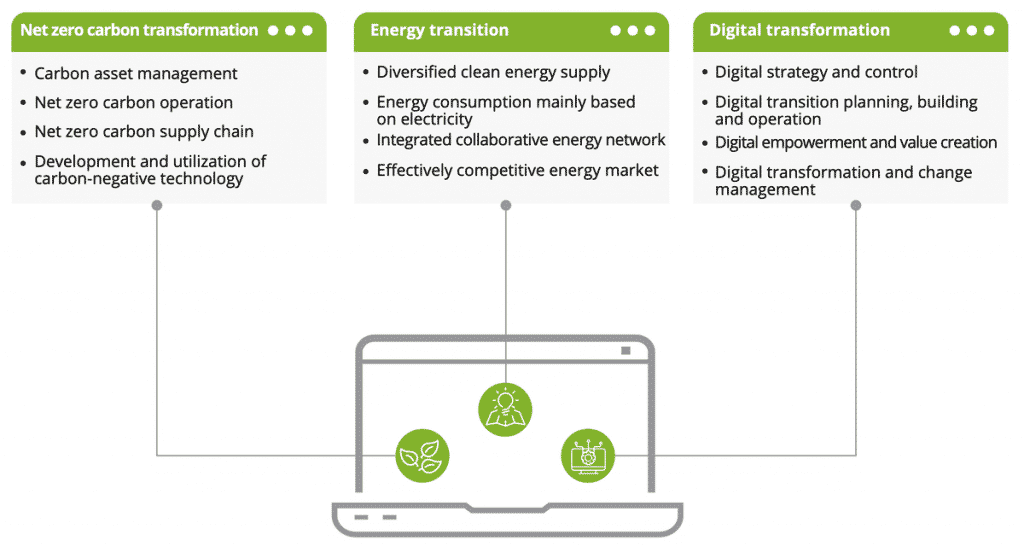In this article, I have summarized a few essential thoughts on digital transformation in the energy sector. Last week I had the pleasure of deepening the dialogue on this topic with Tech Global Thought Leader Elise Quevedo and Edwin Diender, Chief Innovation Officer of the Global Energy Business Unit, Huawei.
In the energy sector, we are always dealing with large numbers — from every perspective. Let me share some of them:
- First, the market size for digital technology in the energy sector. According to Bloomberg NEF, it will be over US$ 60 billion by 2025. And one of the biggest revenue drivers coming from digital technology will be smart meters.
- Second, the climate neutrality agreement. Over 110 countries have committed to achieving this by 2050. On the corporate side, we see increasing demand and also an increase in government support for this important topic. And last but not least, almost 300 companies have committed to covering their energy needs with 100% renewable energies by 2050 or even earlier.
- Third, as an example, the global demand for electricity for electric vehicles. By 2030, this demand is expected to grow to almost 640 terawatts per hour — eleven times more than in 2018.
These figures underline one thing: without a clear path towards digital transformation, these goals cannot be achieved.
“Digital Transformation is a paramount ingredient in the energy industry helping to better manage energy demand. Digital technologies are dramatically cutting the energy consumption of ICT infrastructure. A sector worth keeping an eye on, since The World Economic Forum estimates that digital transformation has the potential to unlock $1.3 trillion dollars of value in this industry by 2025.”
Elise Quevedo
Author, Advisor, and Storyteller
Named Top 50 Women in Tech Influencer 2021
Digital transformation and some of the typical barriers in the energy sector
In the past few years, I have seen a lot of challenges that companies have stopped at. And while they know they need to embark on the journey of digitalization, not all of these companies seem to be making headway.
So what are the typical barriers on the decision-maker side when it comes to implementing digital transformation?
First of all, there is no general answer to this. The starting situation in the individual companies is too different for that. Nevertheless, I see two essential core aspects from different perspectives:
- The psychological factor, including the use of excuses
- The reality of providing physical products and services
Of course, I do not want to use any clichés. So let me explain what I mean by these two aspects.
People, change, and behavior
When it comes to people and change, we often have to overcome mental hurdles first. Each of us can understand that. We, humans, are creatures of habit. In essence, it is about how we deal with these challenges. That makes a big difference.
What I often experience with executives from traditional industries is that they spend hours explaining why the digital transformation cannot be applied to their company or even to their industry. Above all, this is not a satisfactory solution for all stakeholders, especially given the numbers and goals I mentioned at the beginning of this article.
To be fair, however, we must also try to understand their point of view better.
Dealing with physical conditions
The energy sector is not an easy environment. The industry is faced with special circumstances. Let us take the development of a new oil and gas field as an example. In this context, companies have to deal with a wide variety of requirements. Topics such as geophysics, power plants, offshore platforms as well as safety and environmental aspects have a major influence.
In addition, companies in the energy sector mainly have classic business models. These business models cannot be digitally transformed as easily as with a financial institution with non-physical and highly scalable transactions.
In summary, it is once again clear that digital transformation is about more than just technology. As in other traditional industries, the energy sector also depends on a holistic understanding of business, processes, people, and changes in behavior.
“Energy transition is the next wave of innovation for digital transformation.”
Edwin Diender
Chief Innovation Officer of the Global Energy Business Unit
Huawei Enterprise Business Group
In our dialogue, Edwin Diender mentioned Huawei’s Energy Summit “Digital Energy, Powering the Low Carbon Era”. During the summit, customers and partners discussed best practices in using new technologies to transition the energy industry toward carbon neutrality.
Huawei has developed a Trans-Cube methodology. The focus is on three core capabilities: net-zero carbon transformation, energy transformation, and digital transformation. The main goal is to get closer to a net-zero carbon intelligent energy system and achieve global zero-carbon development.

In this context, Edwin Diender also referred to Huawei’s latest white paper on global energy transition and zero-carbon development. It analyzes the current situation and trends of energy transformation and zero-carbon development.
The white paper also points out the direction of future energy development and puts forward the energy transformation pathways of power, oil and gas, and coal industries. You can read more in-depth information in the white paper.
Digital transformation and how it can help decision-makers in the energy sector manage risks
When I think of the energy sector, topics such as operational technology, infrastructure, and cybersecurity come to mind. Since the beginning of COVID-19, we have seen a dramatic increase in cyber threats — and they have gotten “smarter”.
From my point of view, one of the biggest challenges is that the operational technology is NOT on the same level of quality as the information technology. Conversely, this means that companies rarely have the necessary solutions to provide operational security at the highest level.
That is understood, especially when we are aware of two important facts:
- Most businesses are driven by reducing costs
- IT departments are considered to be cost centers
Due to this perspective, a huge gap can arise between the possible efficiency potential and the innovation potential for companies. And last but not least, this also influences the issue of operational safety. Based on this situation, how can digital transformation help manage risks more innovatively and efficiently at the same time?
First and foremost, companies need to know their risk points. And digital transformation can help decision-makers gain more clarity by collecting, analyzing, and managing data with the support of artificial intelligence.
Another aspect is the implementation of digital tools for planning and forecasting as well as more robotics and process automation. To make it a bit more tangible: the Internet of Things (IoT) and the possible machine-to-machine interaction not only enable incoming attacks to be detected more quickly, but also to be largely automatically resolved.
And finally, many OT environments run on legacy systems, which make update processes extremely time-consuming or almost impossible. At this point, digital transformation can also help to close this gap and ensure a vital infrastructure to secure operating components, increase operational reliability, and protect people.
Final thoughts
Digital transformation in the energy sector is a challenging and demanding task at the same time. To advance the necessary changes and thus exploit innovation potential, focus not only on the technology, but above all on the business case, including processes, people, and changes in behavior.
I believe the benefits of investing in this area are far greater than the actual losses from a week of downtime — even though people could be harmed.
I would also like to recommend the dialogue between Elise Quevedo and Edwin Diender on this subject. You can watch the video here.



